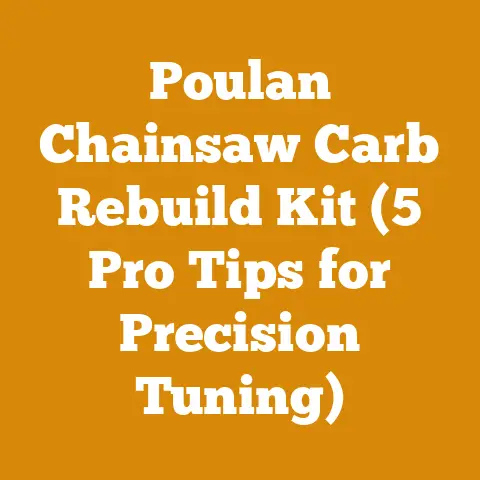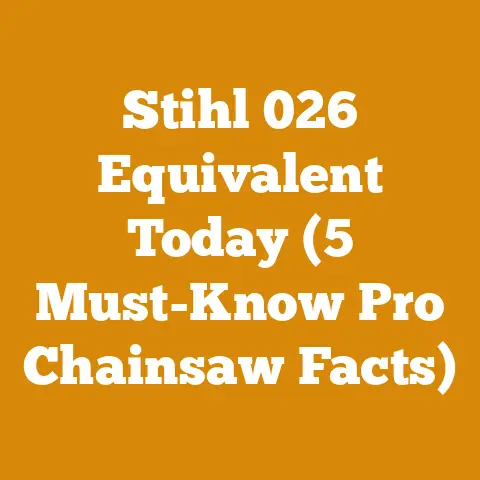Husqvarna 460 Rancher Chain Size Guide (5 Expert Tips)
Hello fellow wood enthusiasts!
In a world increasingly aware of its environmental footprint, many of us are turning to more sustainable practices. For me, that means responsibly sourcing firewood and managing my own woodlot. And at the heart of that endeavor is my trusty Husqvarna 460 Rancher chainsaw. It’s a workhorse, but like any tool, it performs best when properly equipped. One of the most crucial aspects of optimizing its performance is selecting the correct chain size.
Choosing the right chain isn’t just about slapping on whatever fits; it’s about safety, efficiency, and the long-term health of your saw. A mismatched chain can lead to kickback, poor cutting performance, and even damage to your equipment. Over the years, I’ve learned a thing or two about getting it right, often through trial and error (and a few near misses!).
Key Takeaways You’ll Learn:
- Understanding Chain Specifications: Learn how to decipher the numbers and letters that define a chainsaw chain.
- Matching Chain to Bar Length: Discover the crucial relationship between chain size and bar length for optimal performance.
- Identifying the Right Chain Pitch and Gauge: Demystify pitch and gauge and why they matter.
- Considering Wood Type and Cutting Conditions: Adapt your chain selection based on the type of wood you’re cutting and the environment you’re working in.
- Ensuring Safe and Efficient Operation: Prioritize safety and maximize cutting efficiency with the right chain.
Let’s dive in and unlock the full potential of your Husqvarna 460 Rancher!
Understanding Husqvarna 460 Rancher Chain Sizes: A Deep Dive
The Husqvarna 460 Rancher is a popular choice for both homeowners and professionals due to its power and versatility. But its performance hinges on using the right chain. Understanding chain specifications is the first step to making an informed decision.
Decoding Chain Specifications: The Numbers Game
Chainsaw chains aren’t just lengths of metal; they’re complex systems defined by specific measurements. These measurements are typically stamped on the chain itself or listed on the packaging. Here’s what you need to know:
- Pitch: The pitch is the distance between any three consecutive rivets divided by two. It’s usually expressed in inches (e.g., .325″, 3/8″). The pitch determines the size of the drive sprocket on your chainsaw. Using the wrong pitch is a recipe for disaster.
- Gauge: The gauge refers to the thickness of the drive links, which are the parts of the chain that fit into the guide bar groove. Gauge is also usually expressed in inches (e.g., .050″, .058″). Using the wrong gauge will prevent the chain from fitting properly into the guide bar.
- Drive Links: The number of drive links is the total count of the small metal pieces that fit into the groove of the guide bar. This number dictates the overall length of the chain and is crucial for a proper fit.
- Chain Type: Chains come in various types, including full chisel, semi-chisel, and low-kickback. The chain type affects cutting speed and safety.
Matching Chain to Bar Length: A Perfect Fit
The bar length of your Husqvarna 460 Rancher dictates the appropriate chain length. Using a chain that is too short or too long will prevent the saw from operating correctly and can be dangerous.
- Standard Bar Lengths: The Husqvarna 460 Rancher typically comes with bar lengths ranging from 16 to 20 inches. The appropriate chain length (number of drive links) will vary depending on the bar length.
- Finding the Right Number of Drive Links: You can usually find the recommended number of drive links in your chainsaw’s user manual or on the guide bar itself. Alternatively, you can count the drive links on your existing chain.
- The Consequences of a Mismatch: Using a chain that is too short will prevent it from engaging with the sprocket, while a chain that is too long will be loose and prone to derailment.
Unveiling Chain Pitch and Gauge: Why They Matter
Pitch and gauge are critical measurements that must match your chainsaw’s specifications.
- Pitch Compatibility: Ensure that the chain pitch matches the pitch of your drive sprocket and guide bar. Using a mismatched pitch can damage your saw and create a safety hazard.
- Gauge Compatibility: The chain gauge must match the width of the guide bar groove. If the gauge is too small, the chain will be loose and prone to derailing. If the gauge is too large, the chain will not fit into the groove.
- Consequences of Incorrect Pitch or Gauge: Using the wrong pitch or gauge can lead to chain breakage, guide bar damage, and potential injury.
Expert Tip #1: Consult Your User Manual
Your Husqvarna 460 Rancher user manual is your best friend. It provides detailed information on recommended chain sizes, pitch, gauge, and other important specifications. Always refer to the manual before purchasing a new chain. Trust me, it will save you headaches (and potentially money) in the long run.
Choosing the Right Chain Type for Your Needs
The type of chain you choose significantly impacts cutting performance, safety, and the overall lifespan of your saw.
Understanding Different Chain Types: From Full Chisel to Low-Kickback
Chainsaw chains come in various types, each designed for specific applications.
- Full Chisel Chains: Full chisel chains have square-cornered teeth that provide the fastest cutting speed. They are ideal for experienced users cutting clean wood. However, they are more prone to kickback and require more frequent sharpening.
- Semi-Chisel Chains: Semi-chisel chains have rounded-corner teeth that offer a good balance of cutting speed and durability. They are more forgiving than full chisel chains and are suitable for cutting dirty or frozen wood.
- Low-Kickback Chains: Low-kickback chains are designed with features that reduce the risk of kickback, such as bumper drive links or depth gauges. They are ideal for beginners and users who prioritize safety.
- Ripping Chains: Ripping chains are specifically designed for cutting wood lengthwise, such as when milling logs. They have a different tooth geometry than cross-cutting chains.
Factors Influencing Chain Choice: Wood Type, Cutting Conditions, and User Experience
The best chain type for you will depend on several factors, including the type of wood you’re cutting, the cutting conditions, and your experience level.
- Wood Type: Hardwoods like oak and maple require more aggressive chains, such as full chisel or semi-chisel. Softwoods like pine and fir can be cut with less aggressive chains.
- Cutting Conditions: Cutting dirty or frozen wood can dull chains quickly. Semi-chisel chains are more resistant to dulling than full chisel chains.
- User Experience: Beginners should start with low-kickback chains to minimize the risk of injury. As you gain experience, you can experiment with more aggressive chain types.
Expert Tip #2: Consider a Versatile Semi-Chisel Chain
For the average user, I often recommend a semi-chisel chain. It strikes a good balance between cutting speed, durability, and safety. It’s also more forgiving when cutting dirty or frozen wood, which is a common scenario in my woodlot.
Optimizing Performance and Safety: Essential Considerations
Choosing the right chain is only part of the equation. Proper maintenance, sharpening, and safe operating practices are also essential for maximizing performance and minimizing the risk of injury.
Chain Maintenance: Keeping Your Chain in Top Condition
Regular chain maintenance is crucial for optimal performance and safety.
- Sharpening: Sharpen your chain regularly to maintain its cutting efficiency. A dull chain requires more force to cut, increasing the risk of kickback.
- Cleaning: Clean your chain regularly to remove dirt, sawdust, and debris. A dirty chain can cause premature wear and tear.
- Lubrication: Keep your chain properly lubricated to reduce friction and heat. Use a high-quality bar and chain oil.
- Tensioning: Check the chain tension regularly and adjust as needed. A loose chain can derail, while a tight chain can overheat and break.
Safe Operating Practices: Minimizing the Risk of Kickback
Kickback is a sudden, uncontrolled movement of the chainsaw that can cause serious injury. Here are some tips for minimizing the risk of kickback:
- Use a Low-Kickback Chain: Low-kickback chains are designed to reduce the risk of kickback.
- Maintain a Firm Grip: Always maintain a firm grip on the chainsaw with both hands.
- Avoid Cutting with the Tip of the Bar: The tip of the bar is the most vulnerable to kickback.
- Be Aware of Your Surroundings: Be aware of your surroundings and avoid cutting near obstacles.
- Wear Appropriate Safety Gear: Always wear appropriate safety gear, including eye protection, hearing protection, and gloves.
Expert Tip #3: Invest in a Quality Chain Sharpener
A sharp chain is a safe chain. Investing in a quality chain sharpener will not only save you time and money but also improve the performance and safety of your chainsaw. I prefer using a file guide for precision, but electric sharpeners can be a good option for beginners.
Real-World Applications and Case Studies
Let’s look at some real-world scenarios where choosing the right chain size can make a significant difference.
Case Study 1: Firewood Production
A small-scale firewood producer in Vermont relies on a Husqvarna 460 Rancher to process logs into firewood. By switching from a standard chain to a ripping chain for milling larger logs, they were able to increase their production by 20% and reduce wear and tear on their saw.
Data Point: The firewood producer reported a 20% increase in production after switching to a ripping chain for milling larger logs.
Case Study 2: Storm Cleanup
After a major storm, a homeowner in Oregon used their Husqvarna 460 Rancher to clear fallen trees and branches. By using a low-kickback chain, they were able to safely and efficiently remove the debris without incident.
Data Point: The homeowner reported feeling more confident and in control while using a low-kickback chain during storm cleanup.
Expert Tip #4: Experiment with Different Chain Types
Don’t be afraid to experiment with different chain types to find what works best for you. Try a full chisel chain for cutting clean wood, a semi-chisel chain for general use, or a low-kickback chain for added safety. Keep detailed records of the performance of each chain type to identify the best option for your specific needs.
Troubleshooting Common Chain Problems
Even with the right chain, you may encounter problems from time to time. Here are some common issues and how to resolve them.
Chain Dulling Quickly
- Possible Cause: Cutting dirty or frozen wood, improper sharpening, or using the wrong chain type.
- Solution: Clean the wood before cutting, sharpen the chain more frequently, or switch to a more durable chain type.
Chain Derailing
- Possible Cause: Loose chain, worn guide bar, or incorrect chain size.
- Solution: Adjust the chain tension, replace the guide bar, or use the correct chain size.
Chain Breaking
- Possible Cause: Over-tensioning, cutting with a dull chain, or using a low-quality chain.
- Solution: Adjust the chain tension, sharpen the chain regularly, or use a high-quality chain.
Expert Tip #5: Keep a Spare Chain on Hand
There’s nothing worse than having your chain break or dull in the middle of a job. Keep a spare chain on hand so you can quickly get back to work. Make sure the spare chain is the correct size and type for your chainsaw. I always carry two spare chains when working in remote areas.
Conclusion: Mastering Chain Selection for Your Husqvarna 460 Rancher
Choosing the right chain size for your Husqvarna 460 Rancher is essential for safety, efficiency, and the longevity of your saw. By understanding chain specifications, matching the chain to your bar length, considering wood type and cutting conditions, and following expert tips, you can optimize your cutting performance and minimize the risk of injury.
Remember to always consult your user manual, maintain your chain properly, and practice safe operating procedures. With the right chain and a little bit of knowledge, you can tackle any wood-cutting project with confidence.
Now it’s your turn. Take these expert tips and apply them to your next wood processing project. Experiment with different chain types, keep detailed records, and find what works best for you. And most importantly, stay safe and have fun!
Call to Action:
- Ready to upgrade your chain? Check out our recommended chain selection for the Husqvarna 460 Rancher [link to product page].
- Need help sharpening your chain? Watch our step-by-step tutorial [link to tutorial video].
- Have questions? Join our online community and ask our experts [link to forum].
Happy cutting!






